

It's all hands to the pump (as they say) with harvest for long term storage completed for Bramley & Cox apples and Conference pears.
Gala, the number one British apple has started at 'early sites' and about to get going on the remaining regions
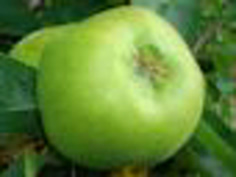 harvesting Bramley at AC Goatham - after viewing the video, exit twitter and return to the EAM Journal.
harvesting Bramley at AC Goatham - after viewing the video, exit twitter and return to the EAM Journal.
Correct harvest date
There is general agreement that apples destined for medium or long-term storage should be in an unripe condition at the point of harvest but close to the onset of ripening (sustained increase in ethylene production and in respiration rate).
Picking too early is to be avoided since fruits are likely to have a tough texture, high acidity, low sugar and poor flavour development. Early picked fruit may also have insufficient red coloration (important for dessert cultivars) and may have increased susceptibility to storage disorders such as superficial scald, bitter pit and core flush.
Late picked fruit are likely to be too soft for the market and to develop disorders such as senescent breakdown during storage or marketing. The general appearance of the fruit may be adversely affected and the background colour may be too yellow for market requirements. In the case of some cultivars such as Gala, skin can become greasy when picked over-mature.
Apples, Hops and Grapes are being harvested in what is proving to be excellent weather for each crop.
The English Apple Man thanks Nigel Jenner - Chief Technical Officer - Avalon Produce Ltd for sharing harvest maturity data
Conference pears
Harvesting for anything but direct marketing/short term storage should now be finished on all sites. Streif indices are now close to 0.7, the level at which harvesting should be completed.
Harvest maturity parameters commonly used include total soluble solids (usually measured with a refractometer), titratable acid, total soluble solids to acid ratio, starch content, background colour and firmness.
In some cases several parameters are combined to provide a single harvest maturity index.
Perhaps the most publicised index is that produced by Streif (1996) which is calculated as follows:
Streif Index Formula
Firmness (kg) measured with an 11 mm probe x 9.81
-------------------------------------------------------------
Soluble solids concentration (%) x starch score (1-10)
As a guide to using the Streif Index, scores should be between: - 1.5 for Long Term Storage - and 0.7 for Short Term Storage
While using the Streif Index is best for calculating Pear harvest dates, Starch + Brix + Firmness is the standard criteria for Dessert apples.
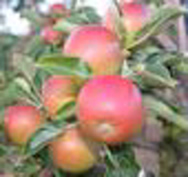 Cox
Cox
Harvesting for long term storage should be nearing completion on all sites. In many cases, firmness has dropped by about 1.0kg, starch has fallen and background colour has mellowed significantly, which indicates fruit is ripening rapidly. As maturity progresses, the level of water core is increasing and you need to be aware of this if you are intending to store any of this later harvested fruit in CA conditions (please refer to earlier newsletter for guidelines on storing fruit with water core). Smartfresh is recommended on all fruit still to be harvested.
Cox is now at 58% Starch - <50% starch is 'the ready for eating' landmark.
Gala
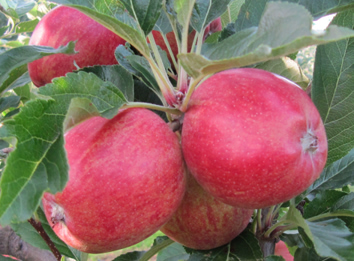 As predicted in last week's newsletter, the rapid decline in starch has now started on all sites and as a result, picking for long term storage should now be underway. In most cases, red colour improved noticeably over the weekend, but has progressed little this week due to the warmer nights.
As predicted in last week's newsletter, the rapid decline in starch has now started on all sites and as a result, picking for long term storage should now be underway. In most cases, red colour improved noticeably over the weekend, but has progressed little this week due to the warmer nights.
Background colour is mellowing rapidly and the warm daytime temperatures this week have meant maturity is now advancing rapidly. The odd 'waxy' apple can already be found on some sites. This may be because the maturity of some of the 'lead apples' is a bit more advanced, but could also be down to nectria eye rot, which is more of a feature in many Gala orchards, due to rainfall over the blossom period. If due to the latter, try to avoid picking these apples, as they are likely to cause a big issue further down the supply chain.
Below: Nectria eye rot in Gala
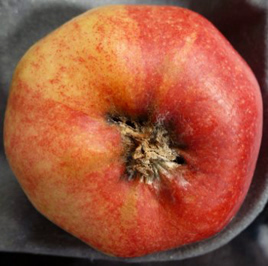 Nectria rot is very well suppressed in the cold temperatures (1.0-0.5oC) in which we store Gala, but it will develop rapidly once the fruit hits ambient temperatures, which will not do much to impress our customers!!!
Nectria rot is very well suppressed in the cold temperatures (1.0-0.5oC) in which we store Gala, but it will develop rapidly once the fruit hits ambient temperatures, which will not do much to impress our customers!!!
Nectria is an infection from canker in apple orchards. The infection spreads in wet conditions and this year we had long periods of rain when the young fruit was forming from blossom into fruitlets.
Rubens
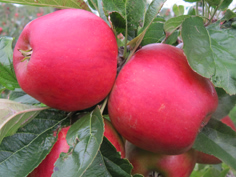 Assessments this week have confirmed that picking should begin next week on most Rubens sites. In many cases, red colour is slow to develop, but as they will need picking more than once, the earlier the first pick is carried out, the more time the second pick will have for red colour to develop, before the firmness starts to decline. It should be remembered that Rubens, like Braeburn is extremely susceptible to CO2 (>1%), so even in air stores, it is vital that the levels remain below this at all times.
Assessments this week have confirmed that picking should begin next week on most Rubens sites. In many cases, red colour is slow to develop, but as they will need picking more than once, the earlier the first pick is carried out, the more time the second pick will have for red colour to develop, before the firmness starts to decline. It should be remembered that Rubens, like Braeburn is extremely susceptible to CO2 (>1%), so even in air stores, it is vital that the levels remain below this at all times.
Rubens averaging 55% starch this week
Hop Picking
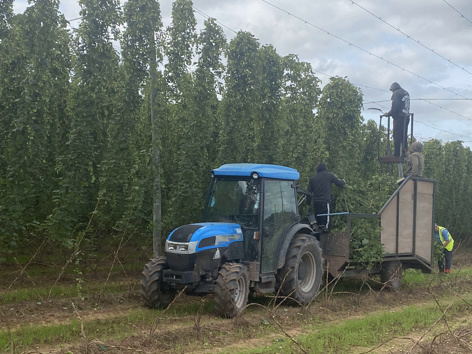 The video's below were posted on Twitter by Hop Grower Ali Capper. Click on to view, but exit Twitter between each video in order to watch each of the three hop harvesting elements
The video's below were posted on Twitter by Hop Grower Ali Capper. Click on to view, but exit Twitter between each video in order to watch each of the three hop harvesting elements
Click on Hops arriving from the hop garden
Click on Hops being picked from the bine
Click on Hops being harvested
Grape Harvest
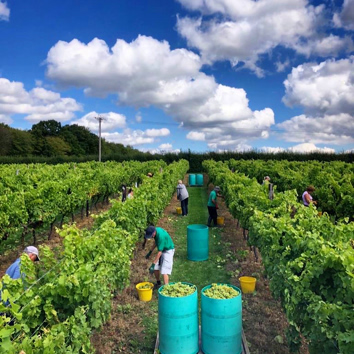 Grape harvesting has been underway for a while and The English Apple Man has been following Biddenden Vineyard on Twitter as they move from variety to variety.
Grape harvesting has been underway for a while and The English Apple Man has been following Biddenden Vineyard on Twitter as they move from variety to variety.
That is all for this week
Take care
The English Apple Man